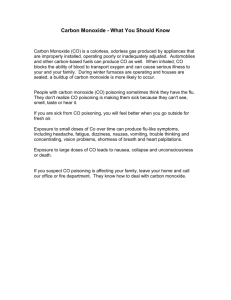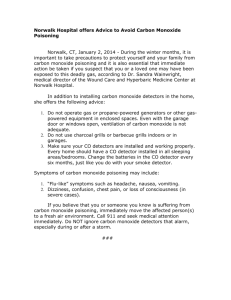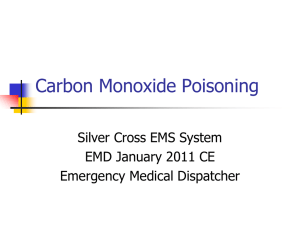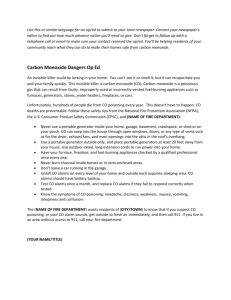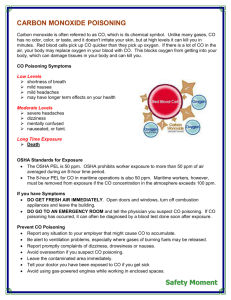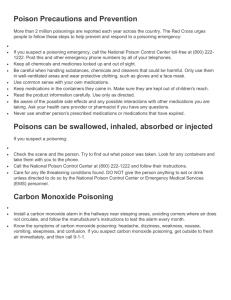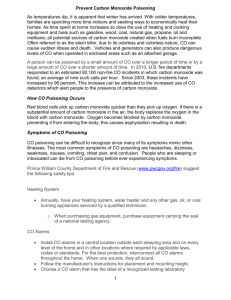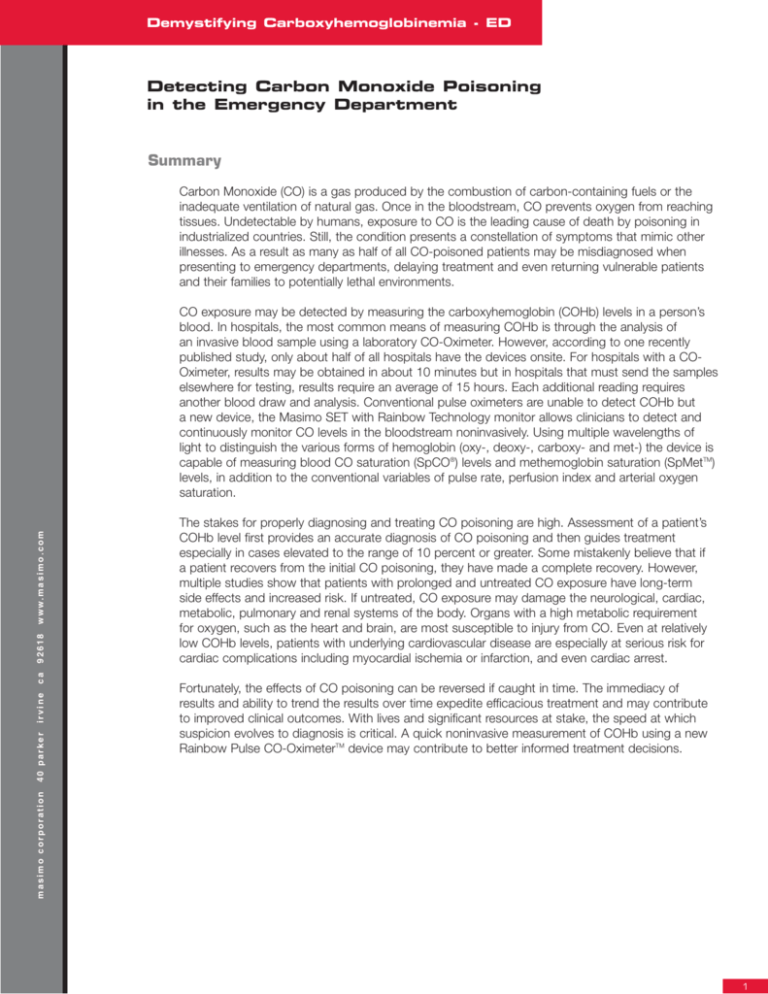
Demystifying Carboxyhemoglobinemia - ED
Detecting Carbon Monoxide Poisoning
in the Emergency Department
Summary
Carbon Monoxide (CO) is a gas produced by the combustion of carbon-containing fuels or the
inadequate ventilation of natural gas. Once in the bloodstream, CO prevents oxygen from reaching
tissues. Undetectable by humans, exposure to CO is the leading cause of death by poisoning in
industrialized countries. Still, the condition presents a constellation of symptoms that mimic other
illnesses. As a result as many as half of all CO-poisoned patients may be misdiagnosed when
presenting to emergency departments, delaying treatment and even returning vulnerable patients
and their families to potentially lethal environments.
The stakes for properly diagnosing and treating CO poisoning are high. Assessment of a patient’s
COHb level first provides an accurate diagnosis of CO poisoning and then guides treatment
especially in cases elevated to the range of 10 percent or greater. Some mistakenly believe that if
a patient recovers from the initial CO poisoning, they have made a complete recovery. However,
multiple studies show that patients with prolonged and untreated CO exposure have long-term
side effects and increased risk. If untreated, CO exposure may damage the neurological, cardiac,
metabolic, pulmonary and renal systems of the body. Organs with a high metabolic requirement
for oxygen, such as the heart and brain, are most susceptible to injury from CO. Even at relatively
low COHb levels, patients with underlying cardiovascular disease are especially at serious risk for
cardiac complications including myocardial ischemia or infarction, and even cardiac arrest.
Fortunately, the effects of CO poisoning can be reversed if caught in time. The immediacy of
results and ability to trend the results over time expedite efficacious treatment and may contribute
to improved clinical outcomes. With lives and significant resources at stake, the speed at which
suspicion evolves to diagnosis is critical. A quick noninvasive measurement of COHb using a new
Rainbow Pulse CO-OximeterTM device may contribute to better informed treatment decisions.
masimo corporation
40 parker
irvine
ca
92618
w w w. m a s i m o . c o m
CO exposure may be detected by measuring the carboxyhemoglobin (COHb) levels in a person’s
blood. In hospitals, the most common means of measuring COHb is through the analysis of
an invasive blood sample using a laboratory CO-Oximeter. However, according to one recently
published study, only about half of all hospitals have the devices onsite. For hospitals with a COOximeter, results may be obtained in about 10 minutes but in hospitals that must send the samples
elsewhere for testing, results require an average of 15 hours. Each additional reading requires
another blood draw and analysis. Conventional pulse oximeters are unable to detect COHb but
a new device, the Masimo SET with Rainbow Technology monitor allows clinicians to detect and
continuously monitor CO levels in the bloodstream noninvasively. Using multiple wavelengths of
light to distinguish the various forms of hemoglobin (oxy-, deoxy-, carboxy- and met-) the device is
capable of measuring blood CO saturation (SpCO®) levels and methemoglobin saturation (SpMetTM)
levels, in addition to the conventional variables of pulse rate, perfusion index and arterial oxygen
saturation.
1
Demystifying Carboxyhemoglobinemia - ED
The Guessing Game
CO poisoning is the leading cause of death by poisoning in industrialized countries1 and may be
responsible for more than half of all fatal poisonings worldwide.2 It is estimated that approximately
43,000 emergency room visits are attributed to CO poisoning in the United States each year.3 At
least 3,800 people die annually in the U.S. from the effects of CO poisoning, and 1,400 of these
deaths are accidental.4-5 Unfortunately, for most patients poisoned by the colorless, odorless,
tasteless gas, CO poisoning is not the immediate and obvious diagnosis. Variable symptoms, a
wide range of patient sensitivity and unsophisticated detection systems often result in misdiagnosis
and treatment delays.
Rapid Determination of Carbon Monoxide Poisoning (COHb)
•
Emergency Departments
•
•
Urgent Care Facilities
• Point of Care – Natural Disaster Zones
•
Physicians Offices
• Toll Booths / Parking Garages
•
Inpatient / Outpatient Surgery Centers
• Airplanes
•
First – Responders/ Emergency Medical
Services and Fire / Homeland Security
• Construction zone
Acute Care Hospitals
w w w. m a s i m o . c o m
Later, physicians at Allegheny General Hospital stated that after receiving three hyperbaric oxygen
(HBO) treatments, McCloy was showing signs of improved brain stem and organ function. MRI
scans illustrated the evidence of neurological damage but the clinical consequences remain to
be seen.
masimo corporation
40 parker
irvine
ca
When pressed for more information, the clinician told the media, “When you put the oxygen
saturation monitor on their finger, it's false [but] it doesn't give you a true reading in somebody
with carbon monoxide poisoning. So you really have to be able to run the blood and check for
carboxyhemoglobin.” In fact, tests run in the subsequent days show McCloy to be suffering from
brain hemorrhaging and edema, muscle injury, liver failure and faulty heart function due to severe
CO poisoning.
92618
Even in the case of Randal McCloy, the sole survivor of the Sago Mine tragedy, in which CO
poisoning was the probable cause of illness (according to multiple published accounts of the
incident), the first physician to attend to the miner reported that McCloy's carbon monoxide levels
were negative. “That means that as best as we can tell with somewhat primitive equipment that we
have here for measuring those, his carboxyhemoglobin levels were negative, indicating no carbon
monoxide in his system, as far as we could tell,” she told reporters.
Some people are more susceptible to longterm harm from CO exposure than others. It is
possible that the same physiology that enabled
McCloy to survive generally lethal CO levels for
more than forty hours may also afford him a
better clinical outcome than would be expected.
While there are populations known to be highly
susceptible to the negative effects of CO:
children, pregnant women, adults with cardiac
disease, individuals with increased oxygen
demand and patients with chronic respiratory
problems; it is not possible to assess a person’s
CO resilience.
Elevated COHb: Patients at
High Risk for Negative Outcome
•
Children; elderly
•
Adults with cardiac disease;
•
Pregnant women
•
Patients with increased oxygen demand or
decreased oxygen-carrying capacity;
•
Patients with chronic respiratory insufficiency.
whitepaper
Symptoms
CO poisoning is the single most common source of poisoning injury as treated in hospital emergency
departments. While its presentation is not uncommon, the constellation of symptoms that manifest when a patient
is poisoned with carbon monoxide do not prompt most clinicians to consider carboxyhemoglobinemia when
attempting a diagnosis. The vague symptoms can be mistaken for those of many other illnesses including food
poisoning, influenza, migraine headache, or substance abuse. In the attempt to find the causative agent for the
symptoms, many unnecessary, potentially costly and sometime resource-intensive diagnostics may be ordered, to
no avail. Because the symptoms of CO poisoning may mimic an intracranial bleed, time and cost for a negative
result may precede proper diagnosis, unnecessarily increasing healthcare costs. During the delay associated with
running unnecessary diagnostics, patients may find that their symptoms abate and their health improves as the
hidden culprit, CO, is flushed from the blood during the normal ventilation patterns over time. Multiple reports have
shown that the patients may be discharged and returned back to the environment where the poisoning occurred,
only to once again be exposed to the silent killer, carbon monoxide.
There are two main types of CO poisoning: acute, which is caused by short exposure to a high level of carbon
monoxide, and chronic or subacute, which results from long exposure to a low level of CO. Which symptoms
appear depend on the level of CO in the environment and the length of exposure, as well as the patient’s state
of health.
The general symptoms of CO poisoning, including headache, dizziness, nausea, fatigue, and weakness, are
vague. See Table 1. Patients with acute CO poisoning are more likely to present with more serious symptoms,
such as cardiopulmonary problems, confusion, syncope, coma, and seizure. Chronic poisoning is generally
associated with the less severe symptoms.14 Low-level exposure can exacerbate angina and chronic obstructive
pulmonary disease, and patients with coronary artery disease are at risk for ischemia and myocardial infarction
even at low levels of CO.15-16
Patients that present with low COHb levels correlate well with mild symptoms described in Table 2 as do cases
that register levels of 50-70%,17 which are generally fatal. However, intermediate levels show little correlation with
symptoms or with prognosis. It seems that the severity of clinical condition is not only related to CO concentration
but also the duration of exposure and the prevailing clinical disposition of the patient. Some patients presenting
with a carboxyhemoglobin level of 20% may be remarkably symptomatic, while others experiencing the same level
of COHb% may exhibit only mild, equivocal symptoms. A patient exposed to high concentrations for a short time
may be less symptomatic than a patient who reaches the same COHb level after a prolonged exposure.
Table 1: Clinical Signs & Symptoms associated with CO
Poisoning and correlated COHb levels18-19
Severity
COHb Level
Signs & Symptoms
Mild
<15 - 20%
Headache, Nausea, Vomiting, Dizziness, Blurred Vision.
Moderate
21 - 40%*
Confusion, Syncope, Chest Pain, Dyspnea, Weakness, Tachycardia,
Tachypnea, Rhabdomyolysis
Severe
41 - 59%*
Palpitations, Dysrhythmias, Hypotension, Myocardial ischemia, Cardiac
arrest, Respiratory arrest, Pulmonary edema, Seizures; Coma
Fatal
60+%
Death
* At moderate to severe levels of COHb posioning the correlation between blood levels and symptomatology is poor.
3
Demystifying Carboxyhemoglobinemia - ED
Detection
Table 2: COHb Levels in Persons 3 - 74 Years of Age20
Percent COHb
(mean + SD)
Percent COHb
(98th percentile)
Nonsmokers
0.83 + 0.67
< 2.50
Current smokers
4.30 + 2.55
< 10.00
All statuses combined
1.94 + 2.24
< 9.00
Smoking Status
One thing that is certain about COHb levels is that smokers present with higher levels than do
non-smokers. As can be seen in Table 2,20 the COHb level in non-smokers is approximately one to
two percent. In patients who smoke, a baseline level of nearly five percent is considered normal,
although it can be as high as 13 percent. Although COHb concentrations between 11 percent and
30 percent can produce symptoms, it is important to consider the patient’s smoking status.
CO poisoning is known as the great imitator for its ability to present with equivocal signs and
symptoms, many of which closely resemble other diseases. In particular, patients may be
misdiagnosed with viral illness, acute myocardial infarction, and migraine. It is estimated that CO
poisoning misdiagnosis may occur in up to 30-50 percent of CO-exposed patients presenting to
emergency departments.21-23 As described below, failing to assess COHb levels early may return
vulnerable patients and their families to potentially lethal environments.
Missing the Signs
A 67-year-old man sought medical help after three days of light-headedness, vertigo, stabbing chest
He was admitted, evaluated and discharged with a diagnosis of viral syndrome. Ten days later he
returned to the ER with vertigo, palpitations and nausea but was sent home for outpatient followup. Four days later he again returned to the ER with diarrhea and severe chest pain, collapsing to
the floor. He was admitted to the Coronary Care Unit with acute myocardial infarction. Among the
results of a routine arterial blood gas analysis, it was found that his COHb levels were 15.6%. A
92618
saturation of 89%. He was admitted to the coronary care unit with a diagnosis of acute myocardial
infarction. The next day a COHb level was measured and normal. While the patient was hospitalized
masimo corporation
40 parker
A 69-year-old man came to the ER after days of confusion, nausea, vomiting, intermittent syncope,
ca
COHb level then obtained on his wife was 18.1%. A rusted furnace was found to be the source.15
irvine
w w w. m a s i m o . c o m
pain, cough, chills and headache. His wife had experienced similar ailments over the past week.
hallucinations and shortness of breath. An arterial blood gas measurement found an oxygen
he invited his sister and daughter-in-law to stay in his home. They both arrived at the ER the next
morning with headaches, vomiting, and vertigo. Their COHb levels on initial observation were 28%
and 32%. The man’s gas water heater was faulty.15
A 47-year-old male urologist and his wife attended a medical conference in Jackson, Wyoming.
Both reported to a local emergency department with symptoms including headache, malaise, and
metabolic acidosis. The husband and wife were sent back to the conference resort hotel with a
diagnosis of gastroenteritis. The following day, they were both found unresponsive in their hotel. He
died 3 hours later, and his wife has severe long-term neurocognitive sequelae. The cause of death
and long-term morbidity was carbon monoxide poisoning due to a faulty boiler. A $17,000,000
verdict was awarded to the afflicted family against the resort hotel owners.
whitepaper
Regardless of the means of detection used in emergency department care, several factors make assessing the
severity of the CO poisoning difficult. The length of time since CO exposure is one such factor. The half-life of CO
is four to six hours when the patient is breathing room air, and 40–60 minutes when the patient is breathing 100
percent oxygen. If a patient is given oxygen during their transport to the emergency department, it will be difficult
to know when the COHb level peaked.15
In addition, COHb levels may not fully correlate with the clinical condition of CO-poisoned patients because the
COHb level in the blood is not an absolute index of compromised oxygen delivery at the tissue level. Furthermore,
levels may not match up to specific signs and symptoms; patients with moderate levels will not necessarily appear
sicker than patients with lower levels.31
In hospitals, the most common means of measuring CO exposure is through the use of a laboratory CO-Oximeter.
A blood sample, under a physician order, is drawn from either venous or arterial vessel and injected into a lab COOximeter. The laboratory device measures the invasive blood sample using a method called spectrophotometric
blood gas analysis.24 Because the CO-Oximeter can only yield a single, discrete reading for each aliquot of blood
sampled, the reported value is a noncontinuous snapshot of the patient’s condition at the particular moment that
the sample was collected. To compound the difficulty of detecting CO exposure, when the laboratory calculates
the patient’s oxygen saturation levels from the oxygen partial pressure (PO2), the arterial SaO2 may appear normal.
The clinical usefulness of CO-Oximetry is inhibited further by the relative deficiency of devices currently installed
in acute care hospitals. One recent study found that fewer than half of hospitals in the U.S. have the necessary
equipment on site to diagnose CO poisoning.25 For those that did not have the testing equipment, the average time
to receive results of a blood sample sent to another facility was over 15 hours. In hospitals that have CO-Oximetry
equipment, results may be returned in an average of 10 minutes (see Table 4.)
Unfortunately, standard pulse oximeters are incapable of isolating the carbon monoxide contaminated hemoglobin
from the oxyhemoglobin.26 Thus, pulse oximeters artificially overestimate arterial oxygen saturation in the presence
of elevated blood carbon monoxide. Therefore, the readings will be falsely high when carbon monoxide is
occupying binding sites on the heme molecule.
Table 3: Comparison of Testing Methods Time to Results25
Testing Method
Average Time to Result
Pulse CO-Oximeter
Seconds
Onsite CO-Oximeter
10 Minutes
Off-Site CO-Oximeter
15 Hours
The latest technology in CO poisoning detection employs a noninvasive and continuous platform. The Masimo
SET® with Rainbow Technology Pulse CO-Oximeter Monitor [Masimo, Irvine, CA] is the first device that allows
clinicians to detect and continuously monitor CO levels in the bloodstream noninvasively. Using 7+ wavelengths
of light to distinguish the various forms of hemoglobin (oxy-, deoxy-,carboxy- and met-) the device is capable of
measuring blood CO saturation (SpCO) levels, methemoglobin saturation (SpMet) levels, in addition to pulse rate,
arterial oxygen saturation, and perfusion index. The device’s accuracy has been demonstrated accurate to 40
percent SpCO, with a range of ± 3 percent around the measurement.27
Noninvasive monitoring reduces the opportunity for hospital acquired infection and overall patient discomfort.
Needle-free testing means a safer environment for patients and caregivers alike. In addition, the immediacy of
results available at the point-of-care results in less drain on resources while expediting efficacious treatment and
better outcomes. The continuous nature of the noninvasive Rainbow Pulse CO-Oximeter device enables the ability
to trend data over time while conventional CO-Oximetry requires a new blood sample each time the status of the
dyshemoglobins is required.
5
Demystifying Carboxyhemoglobinemia - ED
Because clinicians traditionally order blood measurement of COHb only when the condition is
suspected, there has been a tendency to diagnose only the most symptomatic patient whose
exposure history is known. With noninvasive Pulse CO-Oximeter technology now available, one might
expect that many instances of elevated COHb will be discovered among patients without a classic
history of recognized exposure to CO.28
Treatment
Due to the challenges of traditional COHb detection and the lack of correlation between levels and
symptoms, most experts recommend using COHb level only as confirmation of the diagnosis in a
patient with suspected CO exposure. Treatment is then based on the patient’s history and the severity
of symptoms. Still, COHb levels are recommended to guide management especially in cases elevated
to the range of 25 percent or greater.29 Because noninvasive and continuous Pulse CO-Oximetry
allows real-time trend evaluation of the CO-poisoned patient, efficacious treatment protocols can
be quickly identified and implemented. Carbon monoxide toxicity is traditionally treated with either
100% oxygen therapy by mask or high flow device, or by hyperbaric medicine (HBO). A significant
relationship exists between the delay between efficacious treatment, the severity of the CO toxicity,
and the potential for delayed neuropsychiatric and/or abnormal cardiac sequelae.
masimo corporation
40 parker
irvine
ca
92618
w w w. m a s i m o . c o m
Table 4: Carbon Monoxide: Half-life Elimination from Blood
Room Air
240 - 360 minutes
Oxygen (100%)
80 minutes
Hyperbaric Oxygen (HBO)
22 minutes
With the half-life of COHb at four to six hours, a COHb level should be obtained soon after exposure
is suspected. Noninvasive and continuous COHb measurements employing Rainbow technology
provide an increasingly valued diagnostic methodology without delays and potentially costly
missed diagnosis.
Noninvasive Pulse CO-Oximeters capable of immediately and accurately detecting COHb in patients
presenting with a host of symptoms are likely to drastically reduce misdiagnosis and aid rapid
treatment. However, emergency department clinicians will need a guidance protocol for patient
management when they uncover patients suffering from CO poisoning. One such triage protocol was
developed for first-responders28 but applies well for emergency department care. See Figure 1
(next page).
whitepaper
Measure SpCO
0 - 3%
> 3%
No further medical
evaluation of SpCO needed.
Loss of consciousness or
neurological
impairmentation for
SpCO > 25%
Yes
No
Transport on 100% oxygen
for ED evaluation. Consider
transport to hospital with
hyperbaric chamber.
SpCO > 12%
SpCO < 12%
Transport on 100% oxygen
for ED evaluation.
Symptoms of CO exposure?
Yes
No
Transport on 100% oxygen
for ED evaluation.
No further evaluation of SpCO
needed. Determine source
of CO if nonsmoker.
Figure 1: Hampson SpCO Triage Algorithm28
If the SpCO level is 3–12 percent, the elevation could be due either to smoking or another source. If the patient
is experiencing such symptoms as headache, nausea or vomiting, they should receive 100 percent oxygen
and undergo further evaluation and treatment as needed. If the SpCO level is 3–12 percent and the individual
is asymptomatic, no further medical evaluation of the SpCO level is necessary (although the source of the
exposure should be identified and fully understood such that it can be eliminated as a future etiologic agent of CO
poisoning). Without this understanding a patient may be inadvertantly sent from the ED back to the environment
where the poisoning likely occurred.
Hyperbaric Oxygen Therapy (HBO) can decrease the half-life of CO to 22 minutes, induce cerebral vasoconstriction
to reducing intracranial pressure and cerebral edema, and reduce the risk of long-term disability. In particular,
HBO treatment is appropriate for patients who experience unconsciousness, neurological signs, cardiovascular
dysfunction or severe metabolic acidosis, irrespective of their COHb levels.30
7
Demystifying Carboxyhemoglobinemia - ED
Clinical Effects
The stakes for diagnosing and treating CO poisoning are high. Fast, effective treatment can do
much to improve clinical outcomes and contain damage to the neurologic, cardiac, metabolic,
pulmonary and renal systems of the body as described in Table 5.
Table 5: Impact of CO Poisoning on the Body Systems
Neurologic
CO poisoning causes central nervous system depression presenting in a
host of impairments. In mild cases, patients report headaches, dizziness
and confusion. In severe cases, patients may be comatose or develop
seizures. Long-term neurocognitive and neuropsychiatric sequelae are
reported even after moderate to severe single exposures.
Cardiac
CO poisoning causes decreased myocardial function and vasodilatation and a
decreased oxygen delivery to, and utilization of, oxygen by the myocardium.
As a result, the patients may present hypotensive or with tachycardia, chest
pain, arrhythmias or myocardial ischemia. Most deaths from CO poisoning
ultimately result from ventricular dysrhythmias.7 Long-term cardiac sequelae
are reported even after moderate to severe single exposures, increasing
the odds ratio of premature cardiac death.
Metabolic
Respiratory alkalosis (hyperventilation) is possible in mild cases. With severe
exposure, metabolic acidosis may result in elevated levels of acid throughout
the body.
Pulmonary
Pulmonary edema occurs in 10 – 30 percent of acute CO exposures.7 This
may be due to a direct effect on the alveolar membrane, left ventricular
failure, aspiration or neurogenic pulmonary edema.
masimo corporation
40 parker
irvine
ca
92618
w w w. m a s i m o . c o m
Multiple Organ Failure
At high levels, multiple organ failures are expected, with a lethal outcome
likely without immediate treatment to remove the CO.
whitepaper
The effects of CO are not confined to the period
immediately after exposure. Persistent or delayed
effects have been reported. In particular, a syndrome of
delayed neurological effects, often referred to as DNS
may manifest in a myriad of forms. DNS is experienced
by 11 percent to 30 percent of patients who have had
CO poisoning.12,19 The resultant sequelae—confusion,
seizures, hallucinations, persistent vegetative state,
parkinsonism, short-term memory loss, psychosis, and
behavioral changes— may appear anywhere from three
to 240 days after carbon monoxide exposure, even in
patients in whom neurologic impairment isn’t initially
recognized, and may be chronic.31 There is no way of
predicting which patients will suffer such sequelae. In
general, those with more severe initial symptoms are at
highest risk. Most mild cases resolve within two months,
although patients with severe exposure may never make
a full recovery from delayed neuropsychiatric sequelae.20
Lasting Effects of CO
Catherine Mormile was competing in her third
Iditarod race in Alaska when she stopped
at a tent along the route to change her wet
socks. Minutes later, she felt nauseous. Hours
later, she would be unconscious from the
carbon monoxide from a propane heater in an
unventilated tent. With no medical evaluation or
oxygen treatment, she was put back on her sled
to continue for another 4 days by the Iditarod
race officials.
The 51-year-old physical therapist breathed the
odorless gas for three hours. She said it took
her years to recover. Her IQ plunged from 140
to 76. She had to relearn skills such as reading
and writing.
Patients with underlying cardiovascular disease are at risk for cardiac complications. Risk of sudden cardiac
death increases with CO poisoning. Hypotension and inadequate oxygenation can cause myocardial ischemia
or infarction, and even cardiac arrest.15,16,31 Even years after being treated for moderate to severe CO poisoning,
patients who sustained myocardial injury as a result of exposure had an increased risk of death.32
Metabolic disturbances such as respiratory alkalosis and metabolic acidosis, as well as pulmonary and renal
maladies may also arise from CO exposure. Pulmonary edema which occurs in 10–30 percent of acute CO
exposures. The build up of COHb in the blood stream may also cause rhabdomyolysis - the breakdown of muscle
fibers resulting in the release of muscle fiber contents into the circulation. Some of these are toxic to the kidney
and frequently result in kidney damage and renal failure.
9
Demystifying Carboxyhemoglobinemia - ED
Causes of CO Poisoning
Carbon monoxide is a gas produced by the combustion of carbon-containing fuels (oil, kerosene,
gasoline, coal, wood) or the inadequate ventilation of natural gas. It is undetectable by humans.
Faulty furnaces, motor vehicles, motor boat docks with swimming platforms, portable generators,
stoves, gas ranges, and gas heaters are the most common sources of carbon monoxide poisoning.
At one time, it was estimated that 29 percent of unintentional CO-related deaths were due to motor
vehicles exhaust.4 This rate has declined significantly since 1979, likely owing to improved emissions
standards. Before catalytic converters, closed environment exposure to car exhaust could produce
death within 30 minutes.6 CO poisoning occurs most often in the fall and winter months, when
the use of gas furnaces and alternative heat sources increases.1 It also occurs when generators,
which provide power to residences and businesses, are used in poorly ventilated areas. Portable
generators are commonly used in situations where power interruptions are expected (hurricane
zones, ice storms, flood regions). A lesser known source of carbon monoxide is the vapors from
methylene chloride7, a compound commonly found in paint strippers. When the fumes are inhaled, it
is converted in vivo to carbon monoxide.
Pathophysiology
Once in the bloodstream, CO has a multi-prong deleterious effect on the body. But despite the
many adverse mechanisms outlined in Table 6 8-11 each produces the same result: preventing oxygen
from reaching tissues thus causing tissue hypoxia:
Limits oxygen transport
The affinity between carbon monoxide and hemoglobin is more than 200
times greater than that between oxygen and hemoglobin. As a result, CO
more readily binds to hemoglobin, forming carboxyhemoglobin (COHb).12
Inhibits oxygen transfer
CO further changes the structure of the hemoglobin molecule, which inhibits
the already limited oxygen that has attached to be prematurely released
into tissues.
Tissue inflammation
The tissue damage caused by poor perfusion and lack of oxygen attracts
leukocytes to the damaged area. This initiates and sustains an inflammatory
response, causing further tissue damage with increased capillary leakage and
edema.12 This process results in a tissue reperfusion injury, similar to what is
seen in patients who have suffered a myocardial infarction.
Poor cardiac function
Decreased oxygen delivery to, and utilization of, oxygen by the myocardium
may cause tachycardia, arrhythmias or myocardial ischemia.7 Long-term
damage to the heart has been demonstrated even after a single moderate to
severe CO exposure.
Increased activation
of nitric oxide
CO increases the production of nitric oxide, an important component in
peripheral vasodilatation. In systemic inflammatory response syndrome (SIRS),
nitric oxide can increase secondary to CO, or induce CO secondary
to hemolysis.
Vasodilatation
CO increases the production of nitric oxide. Nitric oxide causes vasodilation.
Vasodilatation is responsible for decreased cerebral blood flow and systemic
hypotension.13 Nitric oxide is largely converted to methemoglobin in the body.
Free radical formation
Nitric oxide also accelerates free radical formation. Free radical formation
causes endothelial damage and oxidative damage to the brain.13
masimo corporation
40 parker
irvine
ca
92618
w w w. m a s i m o . c o m
Table 6: Oxygen-limiting mechanisms of CO
whitepaper
Conclusion
The effects of CO poisoning can be reversed if caught in time. Detection and diagnosis of CO poisoning is currently
based upon clinical suspicion and confirmed by invasive blood sampling for COHb analyzed by CO-Oximetry. While
many hospitals have blood gas machines with CO-Oximetry, many smaller hospitals do not, which makes timely
confirmed diagnosis of CO poisoning in these situations impossible. Organs with a high metabolic requirement for
oxygen, such as the heart and brain, are particularly susceptible to injury from CO. The resulting tissue ischemia
can lead to organ failure, permanent changes in cognition, or death. Those that survive the initial poisoning may
experience serious long-term neurological, cardiac, metabolic, pulmonary and renal impairment as a result of their
CO exposure.
With lives and significant resources at stake, the speed at which suspicion evolves to diagnosis is critical. A quick
noninvasive measurement of COHb using the new Masimo Pulse CO-Oximeter device may contribute to better
informed treatment decisions ending the guessing game.
References
1.
2.
3.
4.
5.
6.
7.
8.
9.
10.
11.
12.
13.
14.
15.
16.
17.
18.
19.
20.
21.
22.
23.
24.
25.
26.
27.
28.
29.
30.
31.
32.
Unintentional non-fire-related carbon monoxide exposures—United States, 2001-2003. MMWR Morb Mortal Wkly Rep. 2005;54(2):36-9.
Raub JA, Mathieu-Nolf M, Hampson NB, Thom SR. Carbon Monoxide Poisoning – a public health perspective. Toxicology. 2000;145:1-14.
Hampson HB. Emergency Department visits for carbon monoxide poisoning in the Pacific Northwest. The Journal of Emergency Medicine, Vol. 16, No. 5, pp.
695–698, 1998.
Mott JA, Wolfe MI, Alverson CJ, et al: “National vehicle emissions policies and practices and declining US carbon monoxiderelated mortality.” JAMA. 288:988–995,
2002.
Hampson NB, Stock AL. Storm-Related Carbon Monoxide Poisoning: Lessons learned from recent epidemics. Undersea Hyperbaric Medicine. 2006;33(4):257-263.
Vossberg B, Skolnick J. The role of catalytic converters in automobile carbon monoxide poisoning: A case report. Chest. 1999;115:580-1.
Bartlett D. The Great imitator: Understanding & treating carbon monoxide poisoning. Lethal Exposure. Elsevier Public Safety, Spring 2006.
Piantadosi CA: “Carbon monoxide intoxication.” In: Vincent JL, ed.: Update in Intensive Care and Emergency Medicine. 10:460–471, 1990.
Zhang J, Piantadosi CA: “Mitochondrial oxidative stress after carbon monoxide hypoxia in the rat brain.” The Journal of Clinical Investigation. 90:1193–1199, 1991.
Thom SR: “Leukocytes in carbon monoxide mediated brain oxidative injury.” Toxicology and Applied Pharmacology. 123:234–247, 1993.
Thom SR, Bhopale VM, Fisher D, et al: “Delayed neuropathology after carbon monoxide poisoning is immune-mediated.” PNAS USA. 101(37):13,660–665, 2004.
Harper A, Croft-Baker J. Carbon monoxide poisoning: undetected by both patients and their doctors. Age and Ageing. 2004;33(2):105-9.
Kao LW, Nanagas KA. Carbon monoxide poisoning. Emerg Med Clin North Am. 2004;22(4):985-1018.
Varon J, et al. Carbon monoxide poisoning: a review for clinicians. J Emerg Med. 1999;17(1):87-93.
Wright J. Chronic and occult carbon monoxide poisoning: we don’t know what we’re missing. Emerg Med J. 2002;19(5):386-90.
Mokhlesi B, et al. Adult toxicology in critical care: Part II: specific poisonings. Chest. 2003;123(3):897-922.
Olsen KR. Carbon Monoxide Poisoning: mechanisms, presentation, and controversies in management. J Emerg Med. 1984;1:233-43
Tomaszewski C. Carbon monoxide. In: Goldfrank LR, Flomenbaum NE, Lewis NA, Howland MA, Hoffman RS, Nelson LS, Eds. Goldfrank’s Toxicologic
emergencies. 7th edition. New York: McGraw-Hill; 2002.
Ernst A, Zibrak JD. Carbon monoxide poisoning. N Engl J Med. 1998;339(22):1603-8.
Radford EP, Drizd TA: “Blood carbon monoxide levels in persons 3–74 Years of Age: United States, 1976–80.” US Dept of Health and Human Services PHS.
82–1250; March 17, 1982.
Baker MD, Henretig FM, Ludwig S. Carboxyhemoglobin levels in children with nonspecific flu-like symptoms. J Pediatr. 1988;113:501–4.
Barret L, Danel V, Faure J. Carbon monoxide poisoning: A diagnosis frequently overlooked. Clin Toxicol. 1985;23:309 –13.
Grace TW, Platt FW. Subacute carbon monoxide poisoning: Another great imitator. JAMA. 1981;246:1698 –700.
Cunnington AJ, Hormbrey P: “Breath analysis to detect recent exposure to carbon monoxide.” Postgraduate Medical Journal. 78(918):233–237, 2002.
Hampson NB, Scott KL, Zmaeff JL. Carboxyhemoglobin measurement by hospitals: implications for the diagnosis of carbon monoxide poisoning. J Emerg Med.
2006 Jul;31(1):13-6.
Hampson NB: “Pulse oximetry in severe carbon monoxide poisoning.” Chest. 114(4):1036–1041, 1998.
Masimo Corp.: “Rad-57 Pulse CO-Oximeter.” www.masimo. com/rad-57/index.htm. Accessed Sept. 26, 2005.
Hampson NB, Weaver LK. Non-invasive CO Measurement by First Responders: A suggested Management Algorithm. Lethal Exposure. Elsevier Public Safety,
Spring 2006.
Hampson NB, Mathieu D, Piantadosi CA, et al: “Carbon monoxide poisoning: Interpretation of randomized clinical trials and unresolved treatment issues.”
Undersea Hyperbaric Medicine. 28:157–164, 2001.
Thom SR, Weaver LK: “Carbon monoxide poisoning.” In: Hyperbaric Oxygen 2003, Indications and Results, The Hyperbaric Oxygen Therapy Committee Report.
Undersea and Hyperbaric Medical Society. 11–18, 2003.
Abelsohn A, et al. Identifying and managing adverse environmental health effects: 6. Carbon monoxide poisoning. CMAJ. 2002;166(13):1685-90.
Henry CR, et al. Myocardial injury and long-term mortality following moderate to severe carbon monoxide poisoning. JAMA. 2006;295(4):398-402.
©2008 Masimo Corporation. All rights reserved. Masimo, SET, and
are federally registered trademarks of Masimo Corporation.
Rainbow, Rainbow Pulse CO-Oximeter, SpMet, and SpCO are trademarks or registered trademarks of Masimo Labs. All rights reserved.
7553-4425B-0108
Masimo Corporation 40 Parker Irvine, California 92618 Tel 949-297-7000 Fax 949-297-7001 www.masimo.com

